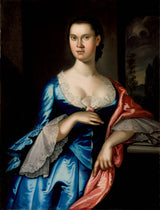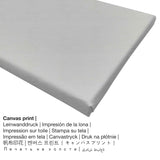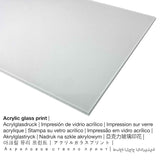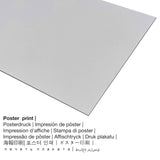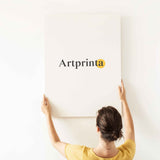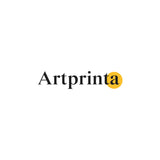John Hesselius, 1762 - Elizabeth Chew Smithi portree - kujutav kunst
Sisaldab käibemaksu. Saatmine arvutatud kell kassasse.
In 1762 John Hesselius created the masterpiece "Portrait of Elizabeth Chew Smith". The version of the painting had the size 38 7/8 x 29 7/16 in (98,9 x 74,77 cm) and was painted with the medium oil on canvas. Besides, this piece of art is in the the digital collection of Los Angeles County Museum of Art, which is the largest art museum in the western United States, with a collection of more than 142.000 objects that illuminate 6.000 years of artistic expression across the globe. With courtesy of - Los Angelese maakonna kunstimuuseum (www.lacma.org) (üldkasutatav litsents).:. Lisaks on joondamine portree ja selle suhe on 3: 4, mis tähendab, et pikkus on laiusest 25% lühem.
Saadaval materjalid
Pakume igale tootele erinevat suurust ja materjali. Individualiseerimiseks on saadaval järgmised valikud:
- Trükitud plakat (lõuendi materjal): A poster is a printed cotton canvas with a fine surface finish. It is suited for framing the art print with a custom-made frame. Please bear in mind, that depending on the absolute size of the poster print we add a white margin 2-6cm round about the print, which facilitates the framing with your custom frame.
- Akrüülklaasist trükk (päris klaasiga): A glossy print on acrylic glass, which is often referred to as a plexiglass print, will change your favorite original into brilliant décor. The great benefit of an acrylic glass print is that contrasts as well as small color details will be recognizeable thanks to the precise tonal gradation. Our real glass coating protects your chosen art print against sunlight and heat for many years to come.
- Lõuendi print: The canvas print, not to be confused with a real canvas painting, is a digital image printed from a UV direct printer. Furthermore, a canvas print creates a soft and comfortable ambience. Your printed canvas of your favorite work of art will allow you to transform your fine art print into a large work of art as you would see in a true gallery. The great advantage of canvas prints is that they are relatively low in weight, which means that it is easy and straightforward to hang up the Canvas print without any wall-mounts. Hence, a canvas print is suited for any type of wall.
- Alumiinium dibond print: An Aluminium Dibond print is a material with an impressive depth. A direct Aluminium Dibond Print is your excellent start to art replicas made on aluminum. For the Direct Print On Aluminum Dibond, we print the favorite artpiece on the aluminium composite white-primed surface. The bright components of the original work of art shimmer with a silk gloss but without glow. The colors are luminous and bright in the highest definition, fine details appear crisp, and you can really feel a matte appearance of the print.
Important information: We try everything in order to depict the products as precisely as possible and to exhibit them visually in our shop. Nonetheless, some colors of the printing material and the imprint can diverge to a certain extent from the representation on the device's screen. Depending on your screen settings and the condition of the surface, not all colors will be printed as realistically as the digital version depicted here. Considering that our art prints are processed and printed manually, there may also be slight variations in the motif's size and exact position.
Toote kohta
| Toote tüüp: | kaunite kunstide reproduktsioon |
| Paljundusmeetod: | digitaalne reprodutseerimine |
| Tootmisprotsess: | UV otseprint (digitaalne printimine) |
| Tootmine: | valmistatud Saksamaal |
| Laotüüp: | tootmine nõudmisel |
| Toote kasutamine: | seinagalerii, kodukaunistus |
| Joondamine: | portree formaat |
| Kujutise kuvasuhe: | 3: 4 pikkus laius |
| Kujutise suhe tähendab: | pikkus on laiusest 25% lühem |
| Materjalid, mida saate valida: | metalltrükk (alumiinium dibond), plakatiprint (lõuendipaber), lõuenditrükk, akrüülklaasist trükk (ehtsa klaaskattega) |
| Lõuendiprint (lõuend kanderaamil): | 30x40cm - 12x16 ", 60x80cm - 24x31", 90x120cm - 35x47 " |
| Akrüülklaasist trükk (päris klaasiga): | 30x40cm - 12x16 ", 60x80cm - 24x31", 90x120cm - 35x47 " |
| Plakatiprindi (lõuendpaber) suuruse valikud: | 30x40cm - 12x16 ", 60x80cm - 24x31", 90x120cm - 35x47 " |
| Alumiiniumprindi (alumiinium dibondmaterjal) variandid: | 30x40cm - 12x16 ", 60x80cm - 24x31", 90x120cm - 35x47 " |
| Raam: | ei sisalda |
Artpiece laud
| Maali pealkiri: | "Portrait of Elizabeth Chew Smith" |
| Kunstiteose kategoriseerimine: | maali |
| Vihmavari: | klassikaline kunst |
| Ajaline klassifikatsioon: | 18th sajandil |
| Loodud aastal: | 1762 |
| Kunstiteoste vanus: | üle 250 aasta |
| Keskmine originaalkunst: | õli lõuendil |
| Originaalsete kunstiteoste mõõtmed: | 38 7/8 x 29 7/16 tolli (98,9 x 74,77 cm) |
| Muuseum / kogu: | Los Angeles County Museum of Art |
| Muuseumi asukoht: | Los Angeles, California, Ameerika Ühendriigid |
| Muuseumi veebisait: | Los Angeles County Museum of Art |
| Kunstiteose litsentsi tüüp: | üldkasutatav |
| Viisakus: | Los Angelese maakonna kunstimuuseum (www.lacma.org) |
Maalikunstnik
| Kunstniku nimi: | John Hesselius |
| Kunstniku sugu: | mees |
| Kunstniku ametid: | maalikunstnik |
| Esitaja kategooria: | vanameister |
| Eluaeg: | 55 aastat |
| Sündinud: | 1719 |
| Surma aasta: | 1774 |
© Autoriõigusega kaitstud | Artprinta (www.artprinta.com)
Lisateave Los Angelese maakonna kunstimuuseumi poolt (© - Los Angelese maakonna kunstimuuseum - Los Angeles County Museum of Art)
Notes from the Curator: The museum’s portrait was painted in 1762, at the peak of the artist’s abilities. The previous year Hesselius had obtained the prestigious commission to paint the portraits of the four children of Benedict Calvert, 1761 (Baltimore Museum of Art). Having begun his career under the stylistic influence of Robert Feke, he had by this point come under the influence of John Wollaston (active 1736-1767), who then was working in the mid-Atlantic region. In his mature work a sculptural feeling for clear forms and volumes recalls the work of Feke. The head, for instance, is isolated as a distinct form, high on a thin neck, its shapes slightly simplified and clarified. The heavy, lidded, almond eyes betray the example of Wollaston, as do the decorative elaboration of lace and extensive patterning of highlights in the drapery. More his own is Hesselius’s use of strong color, in this case a brilliant blue in the dress and bright pink in the shawl, echoed in the high color of the face. The museum’s painting is exceptionally well preserved for the work of Hesselius and consequently unusually impressive. The subject was born in 1742 or 1743, the daughter of Samuel Chew III of Anne Arundel County and his wife Sarah Lock. The museum’s painting is one of four portraits of members of the Chew family executed by Hesselius in 1762. One is a portrait of Elizabeth’s mother, another is of Elizabeth’s brother, Samuel Lloyd Chew (both unlocated), and the fourth is another version of the portrait of Elizabeth (Brooklyn Museum). The other version is smaller (28 3/8 x 25 1/8 inches), and only a bust-length, with Elizabeth Smith wearing a silver dress, with blue bow, and chocolate-colored shawl and holding a sprig of flowers in a slightly different gesture. In 1939 the museum’s painting was the only one of this group of four not in the collection of Samuel Claggett Chew of Bryn Mawr, Pennsylvania. The fact that the museum’s painting descended through Mrs. Smith’s family rather than the Chew family suggests the possibility that it was commissioned separately by Mr. and Mrs. Smith. Since Elizabeth Chew was married on February 11, 1762, it is possible that the present painting was a marriage portrait. Her first husband was John Hamilton Smith, a resident and plantation owner of Calvert County; they had two daughters, Elizabeth Chew and Mary. Her half-sister, Mary, married a Dr. Alexander Hamilton Smith in 1767. (There was a prominent Scottish physician of the same name living in Annapolis in the 1740s.) Records for Saint James’s (Old Herring Creek) Parish show a large family with the name of Smith living there in the early eighteenth century. Elizabeth Chew Smith later married a man named Sprigg. It is not known whether this second marriage produced issue. She died sometime after 1800.

